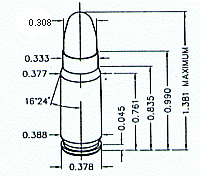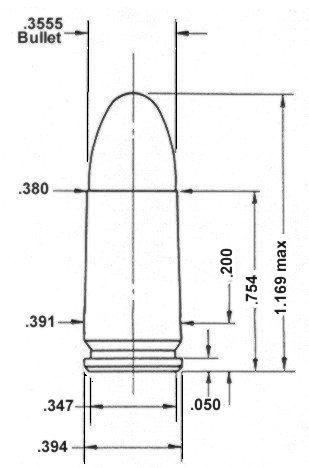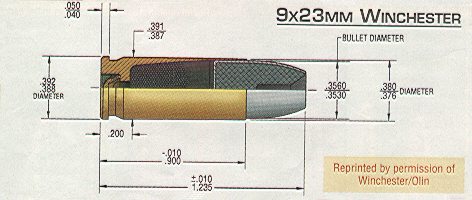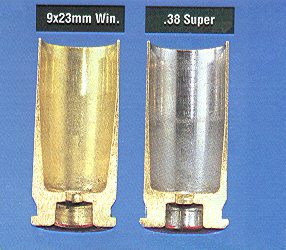RELOADING FOR THE PPSh-41
7.62x25
Bottle necked brass, such as the 7.62x25, should be lubed when reloading. Critical is bullet selection.
First, I had a gunsmith friend "slug" the bores of my barrels. Two were .299-.300 (bore dia.) & .313-.315 (groove dia.) respectively, the other was .301-.302 (bore dia.) & .313 (groove dia.). Trying to get a heavier bullet, I chose the 30 M1 Carbine 110 gr RN (.308). The gunsmith assured me it was ok to use a .308 dia. bullet in the .301-.302 barrel.
However, most of the bullets could easily be pushed back into the case. After working with Redding technical department, the problem was finally identified. It was not my dies, but rather that the 110 gr bullets had a slight taper. This taper made it difficult for the short neck to have enough surface to grip and make a tight fit. Changing bullets made the difference.
The PPSh needs a high velocity to function properly. Using Speer 110gr JSP bullets, Starline 7.62x25 brass, WSP primers and VihtaVuori 3N37 powder at 7.2 grs, the chronograph showed an average velocity of 1525 fps. There was excellent knock-down power on steel pepper poppers. It put down the pepper poppers when the 86 gr. Norinco "yellow box" factory rounds would not. I had a notation in my range notes that I should increase the powder weight to 7.3+ grs.
to ensure constant lockup of the bolt to the sear, since out of ten rounds chronographed, one did not hold the bolt back in the semi mode. Been reloading (June 2001) Remington 110 gr. FMJ-RN with 7.8 gr. VithaVuori 3N37. Chronograph reported an average of 1505 fps (OAL= 1.3788"). Don't know why the earlier test showed the same powder with 7.2 gr. at 1525 fps. Maybe OAL was less. Seems to work fine in full auto mode.
(Oct. 2001) Using the original Russian lower, I found a reload of 7.0 gr VV3N37 with a 110 gr RN bullet works fine. Since I have standardized my 9x23 load at 7.0 gr VV3N37, I think using the same load for my 7.62x25 will simplify my reloading sessions. I'm getting the impression that the Starline 7.62x25 brass may be soft. I've had several split necks and one case separation.
I will be also testing several different powders and bullets and will report my findings on this page.
(Oct. 2004) I have tested Seller & Beloit 7.62x25 brass for reloading. Using .30 M1 carbine 110 gr. RN bullets, VV N350 powder at 7.1 grs, I have reloaded a test batch of 25 pieces ten times with a total of six resulting in split necks. (first split neck after 3 reloadings, 2nd split after six reloadings, next split at 8th reloading and 3 split necks at the 10th reloading.) Seems to me, it is cost effective to buy new S&B 7.62x25 ammo and then reload the brass. S&B is not as hot as my PPSh likes, but the reloads are better.
Some of the loads on the "7.62x25 Reloading" (link below) web site are too low velocity to recycle and eject strongly enough in the PPSh. It appears the velocity needs to be above 1550 fps to function flawless. Work up the loads as suggested in the reloading manuals. Average velocity of Chinese Norinco factory ammo is 1725 fps. (Chronographed on a Chrony at about 9'- 10' distance.)
9x19 
Shooting 9x19 in the PPSh creates some different problems due to the lower velocity of the 9x19 compared to 7.62x25 and 9x23.
You may encounter failures to eject with the 9mm that you didn't have when shooting the Tokarev round. Some bolts of mine eject the 9mm better than others. I will experience some cases not being ejected out of the receiver and when I change bolts, ejection is better. I also suspect that the type of powder one
uses may also determine ejection height of the spent round. A certain bolt seems to shoot the case forward, while another ejects straight upward. The spent casing should eject to a height of 1 to 2 feet in the air as a minimum height in order to have flawless functioning with the 9mm.
Drums and stick magazines can also have an adverse effect on ejection. I had one drum that caused some failures to eject. When I tightened the spring two turns, the ejection problem disappeared.
BTW, I "number" my drums and stick mags using the stick-on numbers that come with VCR tapes. That way, I can keep track of the ones
that seem to be more problem prone.
I haven't read anything concerning the reliability of the 9mm conversions done by the Germans in WWII, but I suspect they were using 9mm ammunition that was specifically made for the MP40 and was hotter than normal 9mm handgun rounds.
I've been reloading 124 gr. RN with 7.0 gr. 3N37 VihtaVuori powder for 1286 fps velocity. The Russian Wolf 115 gr. 9mm chronographs at 1332 fps. My reloads eject better than the Wolf, evidently the heavier bullet is a factor. The VihtaVuori Reloading Guide (1-00) has 6.1 gr. as the maximum load for this powder with Rainier 124 gr. RN.
It shows 6.6 gr. for Sierra 124 gr. FMJ. I reloaded using 7.2 gr. 3N37 and the velocity jumped to 1388! Guess I better look for another powder in order to get my 9mm velocities up to where my PPSh will function flawless with the 9mm.
(Oct. 2004) Loaded some Montana Gold 147 gr RN 9mm bullets (which have a small flat point) using VV N340 powder at 4.2 grs. Initial testing seems to show that this is a good round for the PPSh. Ejection was not real high, but my weapon was throwing the spent cases forward rather than straight upward. I had no jams or spent cases caught in the receiver. I will be doing more testing with this load and bullet to make sure it is a consistent functioning round. According to the reloading manual, this load is supposed to be 977 fps velocity.
(note): I have been using a Hungarian lower receiver for the past few years since it had the "wings" which partially cover the slit between the upper and lower receivers. Using the original Russian lower receiver again, I found that the 9mm functions better than with the Hungarian lower.
When reloading 9mm for the PPSh, it is critical you GAUGE each round before shooting it. Any bullet that does not seat completely in the gauge, or barrel if you don't have a gauge, must NOT be shot in the PPSh-41!; otherwise, an 'out of battery' explosion likely will occur. I have an IPSC shooter friend who has a "Case-Pro" case reformer which I have been using it to put my 9x23 cases back to original factory specs. It works great! Reforms the brass and even the rim, greatly reducing my concern for cases with a "half-moon" ridge from the PPSh barrel chamber feed ramp. I will be using this machine for the 9x19 too. Unfortunately, this reforming machine costs about $400, so without my friend's "Case-Pro", I wouldn't be able to afford one of my own.

9x23
The 9mm Mauser Export was developed in 1908 by DWM, who determined the 7.63x25 Mauser round didn't have adequate stopping power. It is considered by many to be a better cartridge for submachineguns than the 9mm Parabellum (9x19). At the end of World War I, most armies had accepted the 9x19 cartridge for their handguns and considered the 9mm Mauser cartridge too hot for automatic pistols. The 9mm Largo & 9mm Bergmann Bayard are close cousins, but not as powerful as the 9mm Mauser. The Hungarian 39M, 43M, and the Swiss SIG Model MKMO, the primary cartridge used was the 9mm Mauser, which was at that time the most powerful of all the 9mm cartridges. The 9mm Mauser cartridge, with its 126 gr bullet, reaches velocities up to 1500 FPS.
This intrigued me, and I decided to try and replicate the 9mm Mauser to use in my PPSh-41. An IPSC shooter told me about the 9x23 round they were using in competitions. The specs were almost the same as the 9mm Mauser Export, and the modern 9x23 Winchester has a tapered thicker case web for this hotter cartridge. Winchester 9mm Mag (9x29) cases can be used if they are trimmed down. Like the 7.62x25 cases, I lube the 9x23 CP (Competition Proven) cases before resizing.
I also use small rifle primers as an additional safety factor. After trying several powders, bullets and loads, I've settled for 124/130 gr TCJ bullet with VihtaVuori 3N37 powder, 8.0 gr @ 1435 fps. With this load, functioning and ejection are excellent. Originally, I was reloading 124/130 gr. RN with 8.2 gr. 3N37 @ 1551/1556 fps respectively. Energy calculation was 663/699 ft. lbs! Ejection was sky-high and a faster cyclic rate. Even though I experienced no problems or signs of high pressure, I decided to back the powder charge down to 8.0 gr.
Again, I feel it is important to gauge the reloaded rounds to make sure they will seat fully in the chamber.
(Oct.2001) I've found that 7.0 gr. VV3N37 will function very well. It is basically a 9mm Largo load, but I can get more loadings with this reduced load and I should get more loadings from the brass cases. I have started using the same 7.0 gr with my 7.62x25 reloads, thereby standardizing my powder settings on my Dillon 550B press. If I want to "showboat" and impress, then I may use a 8.0 gr load of 3N37.
IPSC shooters have started using this powerful round. Ballistically it is hotter than a .357 Magnum. A hard hitting round that really puts IPSC steel pepper poppers down with authority.
 note: Most CJ96 sites on the Internet and Wikapedia refer to the 9mm Mauser Export as 9x25, which is the same length of the 7.63 Mauser (aka .30 Mauser). Ian Hogg's book "Military Small Arms of the 20th Century (1985 edition) states the length of the 9mm Mauser Export shell case is .90", basically 22.86mm, rounded up is 23mm. The difference between 23mm and 25mm is .075125 inch, which was close enough for my project. This makes the 23mm case slightly shorter than a 25mm case, but with the larger and longer bullet, the 23mm is a longer o/a length. (updated 02-07-16)
note: Most CJ96 sites on the Internet and Wikapedia refer to the 9mm Mauser Export as 9x25, which is the same length of the 7.63 Mauser (aka .30 Mauser). Ian Hogg's book "Military Small Arms of the 20th Century (1985 edition) states the length of the 9mm Mauser Export shell case is .90", basically 22.86mm, rounded up is 23mm. The difference between 23mm and 25mm is .075125 inch, which was close enough for my project. This makes the 23mm case slightly shorter than a 25mm case, but with the larger and longer bullet, the 23mm is a longer o/a length. (updated 02-07-16)
9x23 links: Burns 9x23 page
(9x23 illustrations taken from "Shooting Times" magazine article by Layne Simpson, August 1996.)
Back to PPSh Main Page